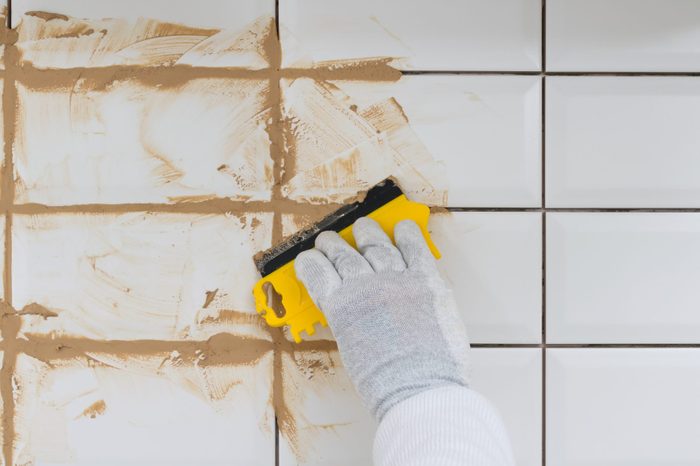What Is Grout? What To Know

Grout rarely gets the attention it deserves when its time to plan a tiling project, but it's more important than you might think.
You’ve probably heard of grout, but do you actually know what it is or does? This unsung hero of the tiling world might lack the excitement and visual appeal of the tiles themselves, but it also provides the backbone for any floor or wall being tiled. By taking some time to learn about grout, you’ll be able to gain further mastery over the craft of tilework.
On This Page
What Is Grout?
According to James Upton, bathroom remodeling specialist and founder of DIYTileGuy.com, “Grout is a cement or chemical-based material used for filling spaces in-between tiles.” He further clarifies that grout is part of the finished look of the tile and not what is used to adhere the tiles to the floor.
Types of Grout
Upton explains that there have been some recent developments with grout, so it’s not as simple to categorize as it was even a few years ago. Essentially, there are two basic types of grout: cement-based and non-cement based.
Cement-Based
The traditional grout that most people are familiar with is made from a cement-based mix. These grouts were only available in sanded or unsanded options in the past, which are porous and vulnerable to stains. According to Upton, a new type of cement-based grout known as “high performance” cement grout is now available. He explains that this new grout is stronger, more color-consistent, and less porous than previous generations of cement-based grouts. Since it’s fast-setting, care must be taken during installation so you don’t find yourself with dried grout before it’s properly washed and detailed.
Non-Cement Based
Epoxy grout— made of epoxy resins combined with a filler— is very hard and durable, and won’t stain like cement-based grouts. Once you mix the ingredients together, a chemical reaction begins and you have a limited amount of time to install the grout before it cures completely.
Single-component grouts are another non-cement-based option. Upton explains that this name is somewhat misleading, as “these used to be solely urethane-based but many of the products on the market nowadays include multiple ingredients and so a more broad category name was required.” These products don’t provide the hardness or stain resistance of epoxy, but in Upton’s opinion, “the finished appearance is more appealing, especially on walls.”
The Purpose of Grout
Although it doesn’t adhere the tiles to the floor as some might think, grout does serve several important purposes.
- Strengthen the Tiles: Tiles can expand and contract during heating and cooling cycles. By filling in the space between individual tiles, grout absorbs this pressure, allowing for movement and preventing tile cracks.
- Visual Appeal: Properly applied grout adds a seamless, professional look to your tilework, and by customizing the width and color, can complement and accentuate the patterns in your tiles. Grout also makes it easier to create mosaics and complex tile patterns by securing tiles in place and preventing them from sliding around.
- Keeps the floor clean: By creating a seamless surface, grout prevents dirt, bacteria, and spilled food from getting caught between tiles. This also makes it much easier to sweep or mop up when it’s time to clean. This also prevents water from seeping into the subfloor, reducing the chances of moisture damage.
Grout Installation Considerations
- Grout joint size: This measurement is the width of the grout between the tiles. Upton explains that “in general, wider grout joints will make it easier to install and line up the tiles during installation. But, it seems that thinner grout joints are more desirable these days.” He adds that a common width is 1/8-3/16-inch, with 1/16th of an inch being the absolute minimum, according to tile industry standards. Learn how to grout the tile.
- Grout sealers: Sealers help to make cement-based grout less porous, but, as Upton explains, they’re not miracle products. Sealers won’t completely seal the pores of the grout or make it totally waterproof or stainproof, although they may help keep some contaminants from penetrating it. Upton adds that many high-performance cement grouts claim that they don’t need to be sealed, but that doesn’t necessarily mean that they won’t benefit from one. Since epoxy and single-component grouts are not cement-based, they won’t benefit from a grout sealer and do not need to be sealed.
- Color: Grout can be a visual element of your tile project as well. A good rule of thumb is to choose a darker color if you want to accentuate the pattern of the tile, and a lighter shade if you want to create a unified, natural look. Darker-colored grout is also easier to keep looking clean, and won’t stain as noticeably as lighter grout.



